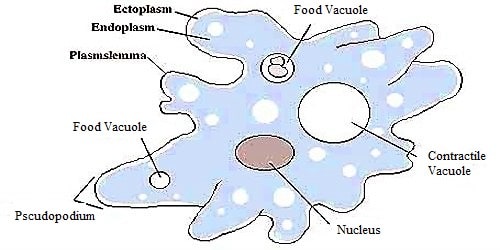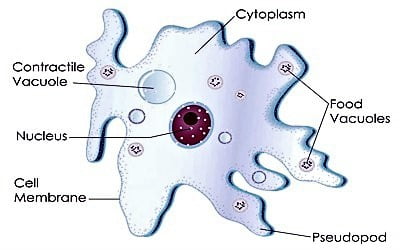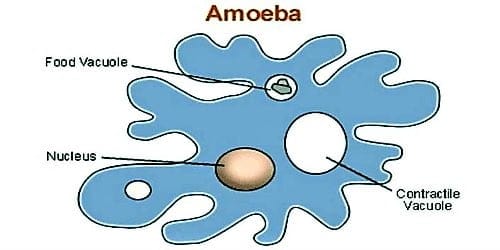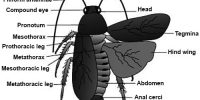There is no definite structure for respiration in Amoeba. They respire through the aerobic process. In absence of any definite organ, their respiration is accomplished by the plasmalemma. Respiratory work mainly occurs through diffusion. The amount of dissolved oxygen of water where Amoeba lives is higher than the oxygen content of cytoplasm. As a result, oxygen can easily enter the body of Amoeba by the diffusion process.
Oxygen is required for respiration. To meet this requirement diffusion continuously occurs in the body of Amoeba. Carbon dioxide produced due to chemical reaction is eliminated from the body in the same manner. This process can easily happen as the amount of carbon dioxide is more in the cytoplasm of Amoeba than in the water.

Excretion: The process by which the nitrogenous waste materials are collected and removed from the animal body is called excretion. The excretory material of Amoeba is mainly ammonia. In dissolved condition, these excretory materials are discharged outside through the plasmalemma by the process of diffusion.
Explanation:
We know that amoeba is a unicellular living thing which lives in fresh water. They have a unicellular life form where a particular cell performs all the processes like nutrition, respiration, secretion, reproduction, etc. They do not have any well-structured organism for breathing. Amoeba has no particular respiratory organs and no respiratory pigments but there is a free exchange of gases by dispersal throughout the common body surface which is permeable to the gases dissolved in water. This life form does not have a particular organ to do the procedure of respiration. Respiration in amoeba is carried out by whole body surface. So in amoeba respiration takes place through its cell membrane also called the plasma membrane. They just take in oxygen throughout diffusion use it to whole the biochemical processes and they discharge the waste products.

Fig: Unicellular Organisms of Amoeba
Diffusion of gases from the surrounding happens through body surface in amoeba. Amoeba gets oxygen gas dissolved in surrounding water throughout its plasma membrane by the procedure of diffusion. The oxygen gas diffused inside the body is used up by amoeba. Oxygen continuously diffuses into the cytoplasm for its absorption in water is constantly superior to in the cytoplasm. Hence, respiration is passed out by gaseous swap between the environment and the organism throughout the cell membrane of amoeba. The oxygen brings about enzymatically assisted oxidation of carbohydrates, fats, and even proteins and breaks them into simpler compounds. In the body, the oxygen gas absorbed is used to break down the multifaceted food substance into plain molecules. In amoeba, respiration takes place by the plain diffusion of gases through the cell membrane. The energy liberated in the oxidation reactions is stored in the high energy bonds of adenosine-triphosphate (ATP). The ATP, like that of any other cell, is the structure of metabolic wastes, carbon dioxide, and water. During these metabolic reactions in the body of amoeba, the oxygen gas is transformed into carbon dioxide gas. The carbon dioxide gas is also liberated in the surrounding water through the similar procedure of diffusion. In amoeba, the by-product of the oxidation of proteins is ammonia. Carbon dioxide and ammonia are excreted out by dispersal in the nearby water as well as in the water discharged by the contractile vacuole.

Fig: Amoeba Circulatory System
Respiration in Amoeba:
- The exchange of gases in Amoeba takes place throughout its cell membrane.
- Amoeba lives in water. The oxygen from water diffuses into the body of Amoeba throughout its cell membrane.
- Since the amoeba is very tiny in size, so the oxygen spreads swiftly into the entire body of Amoeba.
- This oxygen is used for respiration inside the Amoeba cell. This carbon dioxide gas diffuses out throughout the membrane of amoeba into the nearby water.













